‘The Roaring Twenties’. Is this a good description of the USA in the
1920s?
The pace was faster, the
buildings were higher, the morals were looser and liquor was
cheaper..
F Scott Fitzgerald, Echoes
of the Jazz Age (1931)
F Scott Fitzgerald was a
romantic novelist.
* * * * *
This huge topic is really five topics, each one
a big subject, and - as well as a question abut the 'Roaring
Twenties' as a whole topic - you have to be prepared for for a
specific question on just one of the five topics in
the exam.
One the positive side, there were exciting
developments in entertainment and
women's lives.
On the negative side, there was Racism,
Prohibition, and
Organised Crime.
|
Links
A
fantastic old site on the 1920s
YouTube
Mr
Portman's great video
Podcast:
 - Giles Hill on
the Roaring Twenties - Giles Hill on
the Roaring Twenties
Powerpoint:
• The Roaring
Twenties ppt.
|
|
If the term 'roaring twenties' applies to
anything, it applies to entertainment, in which area there were
many exciting developments:
a. Films:
● movie actors such as Charlie
Chaplin, Rudolf Valentino and Mary Pickford became 'stars'.
●
in 1927,The Jazz Singer starring Al Jolson, was
the first 'talkie'.
● a
well-known
early two-colour film was The Toll of the Sea (1922) and
two-colour films were common
by the end of the 1920s; after 1932, films were produced in
three-colour technicolour.
● Mickey Mouse was created by Walt Disney in 1928
(who released Snow White in colour in 1937).
●
by 1930, 100 million Americans went to the movies
every week.
● companies like United Artists and MGM produced
hundreds of films a year.
● films taught people new fashions (e.g. smoking)
and new ways to behave - many girls wanted to be like It' girl,
Clara Bow.
b. Jazz:
●
Jazz was first played in New Orleans by black musicians such as
Louis Armstrong and Jelly Roll Morton. After 1917,
racist violence forced many of them to leave New Orleans, so
they went north to play in the night clubs of towns like Chicago and New York.
●
The invention of radio and the phonograph (record
player) made it available in people's homes. The
first jazz record was made in 1917 by the Dixieland Jazz Band.
They were called 'race records', because they were recorded by
black musicians.
● Because it was often played in speakeasies,
by black musicians, it was seen as wild and exciting - which
soon made it very popular.
● Jazz music contributed to many of the social
developments of the age - baggy trousers and short skirts, wild
dancing such as the Black Bottom, and a new kind of
convention-free poetry called 'jazz poetry' (poets such as TS
Eliot and ee cummings). It was part of the Harlem
Renaissance, and the growth of black pride (see below).
c. Dances:
● The Charleston was a fast dance developed in Black
communities which was adopted by flappers, who danced it alone
to challenge the 'drys' who wouldn't go out to clubs.
(Both Joan Crawford and Ginger Rodgers began their movie careers
by winning Charleston competitions.)
●
The 'Black Bottom Stomp' was
first recorded by Jelly Roll Morton and named after Black Bottom
- a Black neighbourhood in Detroit. After 1926 it
became the most popular dance.
● The dances scandalised many Americans, who thought
they were immoral.
|
Links
FANTASTIC
CLIP of the original Charleston!
Clara Bow
in 'It' - clips from the film.
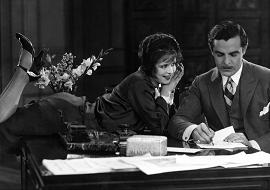
Clara Bow - the 'It' girl,
playing
self-confident shop-girl
Betty Lou Spence, who has
‘it’ and is ‘it’, flirting with rich businessman Cyrus
Waltham.
Watch the
movie
'It' on YouTube.
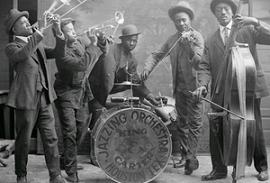
The King & Carter
Jazzing Orchestra, 1921.
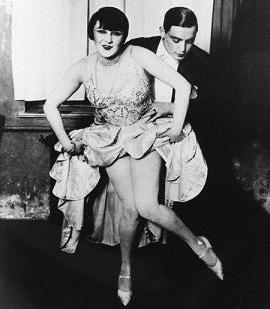
The Charleston
|
|
How significant were the changes in women's lives
in the 1920s?
Argument 1 - VERY significant:
a. Work: Many women had taken
over jobs traditionally reserved for men (such as
manufacturing), and 1920-29 the number of working women
increased by 25%; many went to be teachers and secretaries.
b. Vote: In 1920 the 19th Amendment gave
women the vote. The former suffrage campaigners
formed themselves into the
Woman's Joint Congressional Committee, which lobbied
successfully for a Maternity and Infancy Protection Act (1921),
equal nationality rights for married women (1922), and the Child
Labor Amendment (1925).
c. Flappers: dumped the old restrictive
fashions, corsets etc. in favour of short skirts, short hair,
and the flat-chested 'garconne' look. Many of them
wore men's clothing. They smoked, drank, used
make-up, played tennis, and danced wildly in jazz clubs.
Some were openly lesbian, others were sexually active.
Argument 2 - NOT significant:
a. Work:
most working women were in low-paid jobs, and they were paid
less than men for the same job.
10 million women were working in 1930 ... but this was still
only a quarter of the females age 15 and over; the rest worked
for free in the home and on the farm.
b. Vote: Apart from exceptions such as
Florence Kelley and Alice Paul, few suffrage campaigners went
into politics; they gave up politics and returned to being
housewives. Women campaigned in vain after 1920 for
an Equal Rights Act.
c. Flappers:
The flappers
scandalised many Americans - the Anti-Flirt Association tried to
persuade young Americans to behaved decently.
Most girls, especially
in rural America, still behaved 'decently', got married and had
babies.
|
Links
Youtube of original footage
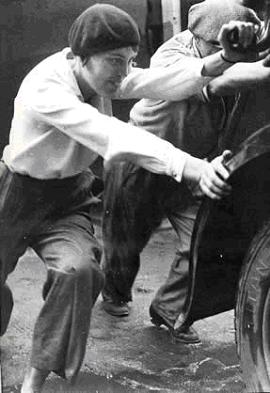
The 'flapper', wearing
trousers and pushing a car along with the men - or is this a
posed photograph?
|
|
How far were the 1920s a time of racism and
discrimination for Black Americans?
Argument 1 - A time of racism [HACKLE]:
a. Hostility to
immigrants: and the Red Scare' - see
this page for more information.
d.
American Government:
refused to pass laws banning lynchings or giving Black Americans
the vote.
c. Jim Crow Laws:
the name for laws passed in the southern states which
prevented Black Americans from mixing with whites
('segregation'), denied them equality of education and civil
rights, and prevented them from voting.
b. Ku Klux Klan:
an organisation to maintain WASPs supremacy, which had 5 million
members by 1925. Many supporters were poor whites,
who did not want Blak Americans to be their equals/fear they
would take their jobs, but many were racism wealthy white
Americans. They wore white sheets and hoods, and
marched with burning crosses. They spoke with each
other in a secret language which they called 'Klonversations'.
They attacked, tortured and killed Black Americans, but also
Jews and Catholics and 'immoral' people such as alcoholics.
e.
Lynchings: mobs of white
people often hanged ('lynched') Blacks Americans whom they
suspected of a crime (usually the police turned a blind eye).
f. Even in the north:
Black Americans ended up with the low-paid menial jobs,
such as janitors,
bootblacks, cooks, houseboys, baggage handlers, waiters,
doormen, dishwashers and washroom attendants. In
1919, white Americans in Chicago rampaged through
Black neighbourhoods after a drowning black man clinging to a
log had drifted into a whites-only swimming area.
Argument 2 - A time of flowering
[RHINO]:
a. Role
models: some Black Americans became famous - the
sprinter Jesse Owens, the baseball player Jackie Robinson, the
dancer Josephine Baker. They were an inspiration to
other Black Americans.
b. Harlem
Renaissance: a cultural flowering
in the New York Black neighbourhood of Harlem,
based on jazz, but also excellent Black
architects, novelists, poets and painters. Many of
these believed in 'Artistic
Action' - winning equality by proving they were
equal.
c. Identity:
in 1925 Alain Locke wrote The New Negro, who had
to smash the old image of 'Uncle Tom' and 'Sambo', and develop a
new identity, 'uplift' the race and fight for equality.
There were Black newspapers and magazines. This was
the time when the phrase was coined: 'Black
is Beautiful'.
d. NAACP:
Set up in 1909, it campaigned for civil rights.
e. One-and-a-half
million Black Americans migrated from the south to the
north. Although many of them ended up in low-paid
jobs, some of them formed a new Black middle class, and were
educated at university.
|
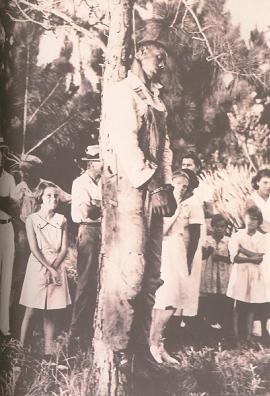
A lynching (1935) - note the
children.
Source A
In the morning, a Black mother sent her children to a school
for colored children only. Going to town, she
sat at the back of the bus, in the seats for coloreds.
She went to the posy office for coloreds, visited the
library for coloreds, and walked in a separate park.
When she went shopping, she stood in line, so White women
could go in front of her.
Her husband went to work, but
he was not the boss; that was a job for a White man.
He used a separate rest room, and went to a separate toilet.
John D Clare, The
Black Peoples of America (2001)
Links
YouTube
on the Harlem Renaissance.
Harlem Renaissance women
|
|
In 1919 - as the result of a long and powerful
campaign (see Source B) - the 18th Amendment to the Constitution
made the manufacture, transport or sale of alcoholic drinks
illegal. The Volstead Act, passed at the same time,
declared any drink more than 5% proof 'alcoholic'.
Argument 1 - A failure [DAMAGE]:
a.
Drinking continued:
impossible to enforce (not enough police - only 4000 agents,
many of whom were sacked for taking bribes).
b. Available:
the liquor trade just 'went underground'.
speakeasies (illegal bars), moonshine (illegally-made alcohol),
bootlegging (smuggling alcohol to sell).
It is sometimes asserted that there were more speakeasies than
there had been saloons (not true, but there were 200,000
speakeasies in 1933).
a. Made criminals of
ordinary people
a. Adverse
effects: moonshine was poor quality
and sometimes killed people. 'Jackass brandy' caused
internal bleeding, 'Soda Pop Moon' contained poisonous alcohol.
a. Gangsterism flourished
running the illegal trade:
It became hugely
profitable, and led to a
growth of violence, protection rackets
etc. associated with the illegal trade (see 'Organised
Crime' below). The general
flouting brought the rule of law in general into disrepute
as police 'turned a blind eye. Corruption grew.
a. End: in 1933 the
21st Amendment abolished Prohibition (= 'proved' that it
failed).
Argument 2 - A Success [ALE]:
a. Alcohol
destroyed:
in 1929, 50 million litres of illegal alcohol
were discovered and destroyed.
b. Legacy:
the actual consumption of alcohol fell, not just
during prohibition, but for many years after - did not reach
pre-1914 levels until 1971.
c. Eliot
Ness and the Untouchables:
became famous as examples of the high standards
police SHOULD achieve.
|
Links
Brilliant Prohibition mindmap.
Good
essay arguing the traditional case that Prohibition was a
failure.
This
site shows that Americans used many other addictive
substances before 1919
 Great
student's video
Great
student's video
Powerpoint:
• Prohibition
ppt.
Source B
Why Prohibition
[ACRIME]
a.
Anti-Saloon
League - campaigned that drink
hurt families because men wasted money on beer, that it ruined
their health and lost them their jobs, and that it led to domestic
violence and neglect.
b.
Christian organisation – esp.
Women's Christian Temperance Union – supported prohibition.
(The early 20th century was a time of Christian revival.)
c.
Rural
America –
scandalised by behaviour in the towns
– supported it.
d.
Isolationism
– it was said that money spent on drink ‘flew away to Germany’
because much of the beer drunk in America was brewed there.
e.
Madness,
crime, poverty and illness were seen as caused by alcohol - many
(including BOTH my grandparents, 'signed the pledge' never
to drink.)
f.
Easy
Street –
Charlie Chaplin’s comic film (1917) showed how
drink damaged, and Christianity nurtured, families' happiness
and prosperity.
Source C
Why Prohibition
Failed [NCP]
a.
Not
enough Agents - only 4000
b.
Corruption and bribes – one
tenth of Agents sacked for taking bribes
c.
Public
support – most
people did NOT support a ban.
|
|
Organised crime stepped in to take over from the
breweries and spirits manufacturers:
a. They ran the
speakeasies, and bootlegging.
b. They also ran
protection rackets, prostitution and drug-running.
c. They
bribed trade union leaders, police, lawyers, judges and even
Senators.
d. The
most famous gangster was Al Capone, who earned $100,000 a year
from beer sales alone, ran a private army of more than 700
mobsters, and is thought to have murdered more than 200
opponents.
e. They
fought with each other for control of their 'territory' - the
most famous incident was the
St Valentine's Day Massacre in
1929, when 'torpedoes' from Capone's gang shot dead 7 members of
Bugs Moran's gang.
Source D
Prohibition is a business. All I do is supply a public demand. I do it
in the best and least harmful way I can
Al Capone
|
Links
St
Valentine's Day Massacre - description
History Learning
Al Capone: Crime Library
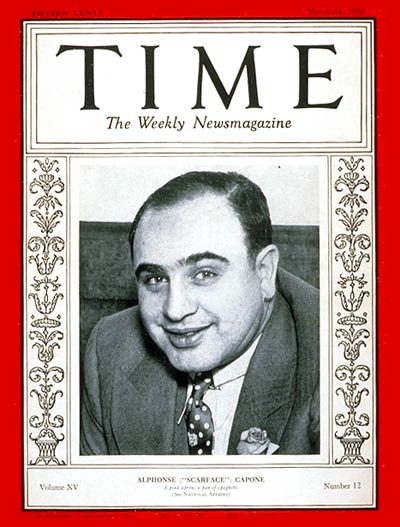
In 1930, Al Capone made the
front page of
Time magazine |
|
|
|
|
|
|
|
|
|
|
|
|